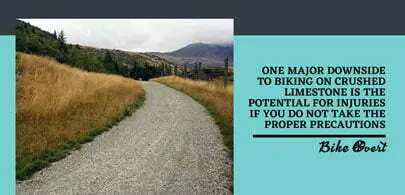Can You Ride a Road Bike on Crushed Limestone? What are the problems with crushed limestone trails for bike riding?
Road biking is a popular sport, but what if you don’t have a paved road to ride on? Can you still enjoy a good bike ride? Many people think that the only way to ride a road bike is on a paved road, but that’s not true. You can also ride on crushed limestone. Crushed limestone is a type of gravel that is made up of small pieces of rocks and stones. It is used to make roads, driveways, and bike paths.
There are many types of bike paths and trails, each with its own unique set of pros and cons. In this article, we’ll explore the option of riding a road bike on crushed limestone. We’ll look at the benefits and drawbacks of this option, as well as some other popular choices.
What are the problems with crushed limestone trails for bike riding?

There are many benefits to biking, including improved cardiovascular health, reduced stress levels, and weight loss. However, one major downside to biking is the potential for injuries if you do not take the proper precautions. One such injury is caused by crushed limestone.
Crushed limestone is a type of road surface that can cause serious injuries to cyclists. The stones can become lodged in tires and cause cyclists to lose control of their bike. Additionally, the stones can cause significant damage to bikes and equipment.
If you are cycling in an area that has a lot of crushed limestone, be sure to take extra precautions to avoid serious injury. Wearing a helmet and other safety gear is essential, as is being aware of your surroundings. If there is a lot of crushed limestone on the road, try to find an alternate route or ride during off-peak hours when the roads are less crowded.
What can be happened to you if you ride bike on crushed limestone?

Riding a bike on crushed limestone can be dangerous. If you’re not careful, you could end up with a flat tire or worse. The rocks in the limestone can cause your tires to puncture or get stuck in the treads. You could also lose control of your bike and crash. So if you’re going to ride on crushed limestone, be sure to take it slowly and watch out for hazards.
What type of bike is best for gravel roads?
When it comes to gravel roads, there is no one perfect bike. It depends on the rider’s needs and preferences. For example, some riders might prefer a mountain bike because it can handle rougher terrain, while others might prefer a road bike because it is faster and more efficient on paved surfaces. But there are some bikes that are primarily designed to run on gravel roads.
It is important to consider the width of gravel roads when choosing a bike. A road bike might be too narrow for some gravel roads, while a mountain bike might be too wide. In general, narrower tires provide less traction than wider tires, but they are also faster and more efficient on paved surfaces. Wider tires provide more traction than narrower tires, but they are also slower and less efficient on paved surfaces.
Ultimately, the best type of bike for gravel roads depends on the rider’s needs and preferences.
What do you need and your bike for riding on crushed limestone?
If you’re looking for a new cycling challenge, crushed limestone might be the perfect surface for you. This is a great surface to ride on if you want to mix up your routine and explore some new terrain. Before you head out on your bike, though, there are a few things you need to know.
The first thing you need to do is make sure your bike is ready for the challenge. If your bike isn’t properly tuned, it can be more difficult to ride on this type of surface. In addition to having the right bike, you’ll also need some basic gear for cycling on crushed limestone.
You need good tires
When you are riding on crushed limestone, it is important to have good tires on your bike. If you don’t have good tires, you may end up slipping and sliding all over the place. This can be very dangerous, especially if you are riding on a road with cars.
It is also important to make sure that your tires are properly inflated. If they are not inflated properly, it can be difficult to ride on the crushed limestone. You may also end up getting a flat tire if you’re not careful.
So, if you’re planning on riding on crushed limestone, make sure that you have good tires on your bike and that they are properly inflated. It will make the experience a lot safer and more enjoyable for you.
You need a bike that has a good ground clearance
Bicycles that are designed for riding on crushed limestone trails generally have a good ground clearance. This is important because if your bike doesn’t have enough clearance, it will get stuck on rocks and other debris that is common on these types of trails. A good ground clearance will also help you avoid getting your bike stuck in mud or puddles.
Your bike should have fenders
If you’re looking to ride on crushed limestone, you’ll need to have good fenders on your bike. This is because the debris and smaller rocks that get kicked up from the tires can fly into your face and clothes, which is both uncomfortable and unhygienic. Fenders help to keep you clean and protected while you’re out on your ride.
You must need to have a strong frame and fork protection
When riding on crushed limestone, a common surface for mountain biking and bike touring, it is important to have strong frame and fork protection to avoid damage. The jagged rocks can quickly wear down the paint and metal on your bike. Frame guards and fork boots are the best way to protect your investment.
Frame guards are plastic or metal covers that fit over the frame of your bike. They can be purchased at most bike stores or online. Fork boots are rubber or plastic covers that fit over the forks of your bike. They can also be purchased at most bike stores or online.
Both frame guards and fork boots are relatively inexpensive, easy to install, and provide great protection for your bike. Be sure to check with your local bike shop to see what products they recommend for riding on crushed limestone.
You need good brakes
When riding on crushed limestone, it is important to have good brakes on your bike. If you don’t have good brakes, you could end up crashing into something or someone. It’s also important to be able to control your bike, so you don’t go too fast or too slow. Riding on crushed limestone can be a lot of fun, but it’s important to be safe while doing it.
What should be in your mind while biking on limestone?

When biking on limestone, you should be aware of the loose rocks that can cause you to lose control. You should also be careful of the steep drop-offs that can lead to serious injury. In addition, you need to watch out for sharp points and edges that can easily cut you. Finally, be aware of the potential for flash flooding, especially if it has been raining.
How much faster is a road bike than gravel bike?
This is a question that has many answers. The type of terrain, the weight of the rider, and the wind all play a role in how fast each type of bike will travel. Generally speaking, a road bike will be faster on paved surfaces while a gravel bike will be better suited for off-road riding. However, there are many other factors to consider when trying to answer this question.
One important consideration is the tire width. A road bike typically has tires that are narrower than those on a gravel bike. This allows for a smaller contact patch with the ground, which means less friction and therefore higher speeds. Additionally, road bikes are often lighter than gravel bikes, which also contributes to their faster speeds.
Can road bikes use gravel tires?
There is a lot of debate on whether or not road bikes can use gravel tires. Some people say that it’s not safe to do so, while others believe that it’s the perfect way to add versatility to your bike. Ultimately, the decision is up to the rider. If you’re comfortable using gravel tires on your road bike, then go for it! Just be sure to take into consideration the added weight and rolling resistance of the tires.
Can a gravel bike be a road bike?
Gravel bikes are becoming more and more popular, but can they really be used as a road bike? Gravel bikes typically have wider tires and a geometry that is designed for off-road riding, but this doesn’t mean that they can’t be used for road riding. In fact, many people use gravel bikes as their everyday commuter bike because they are comfortable and durable.
Gravel bikes can also be used for racing, and there are now many gravel races that are popping up all over the country. If you’re looking for a versatile bike that can do it all, a gravel bike may be the right choice for you. Just keep in mind that they may not be as fast as a traditional road bike on pavement.
Conclusion
Can you ride a road bike on crushed limestone? The answer is it is possible to ride a road bike on crushed limestone. However, it is important to take into account the condition of the surface before attempting to do so. Always be sure to wear a helmet and other protective gear when riding, and be aware of your surroundings. If you are unsure about the condition of a surface, it is best to avoid riding on it.




